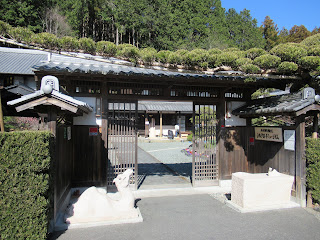The Silk Road was an ancient network of trade routes between Chang’an (present Xi'an) in China and Rome where caravans traveled. This is the gate of the museum, with an image of a camel in front of it. The building itself is also very rare and worth seeing. It was the house of a wealthy farmer and originally built in the Edo Period without using any nail.
The items from the Silk Road were displayed on the second floor. The first exhibit was a statue of Maitreya from Ghandara, Pakistan, A.D. 3C. It was just in front of the end of the stairs. As soon as I saw it, I automatically put my hands together and bowed though I’m not very religious. The statue was so vivid.
There was also a head of Buddha from Ghandara, Pakistan, A.D. 3 - 4 C. His expression was the mildest I’ve ever seen.
This is a part of a Persian carpet from Iran, A.D. 8 – 10C (Sassanian Empire), and there are only several pieces of similar old cloth in the world today. It was amazing that colors of the wool were preserved very well. According to the museum staff, this piece is bigger than the one in Shosoin (treasure repository in the ancient capital Nara) and is exhibited only in winter when the air is dry.
It was also interesting to hear about the history about precious things. This is a part of a corridor floor of a palace found near Istanbul, Turkey (A.D. 4 – 5C). It is mosaic made of small pieces of stones of various colors. I found some exotic animals on it. The museum staff explained that rich people boasted their wide knowledge by using animals in foreign countries as motifs.
As he talked, he touched the mosaic and let me do it, too. To my surprise, you can touch exhibits (not in the cases) freely in this museum! I came back to my favorite statue of Maitreya and touched his left hand.
The exhibition continues to the other rooms.
As this museum was once a wealthy farmhouse, you can see a beautiful garden and a big storehouse from the corridor.
These are roman glass from the eastern Mediterranean Sea, around the beginning of the first century.
From A.D. 7 to 9C, many Japanese envoys were sent to Chang’an, which was the capital of Tang Dynasty and the starting point of the Silk Road, to learn the advanced governmental system and culture of China. The museum has Tang Sancai pottery,
as well as painted terracotta made during this dynasty.
On the second floor, there were many other interesting things, and the exhibits are basically changed semi-annually. As for the first floor, the main exhibits are Japanese pottery. Now, they have two special exhibits. One is bridal costume of a granddaughter of Prime Minister Masayoshi Matsukata (1835 - 1924), which consisted of two kimono. This one is embroidered all over by skillful craftsmen with silk threads of the highest quality that are no longer available these days.
The other is a set of hina-dolls for the Doll Festival in March, which a sumo star Chiyonofuji prepared for his daughter. The dolls are all Hakata dolls made from clay.
And beyond these, there was still one remarkable object: a porcelain plate from Jindezhen, China made 100 - 200 years ago. This may be the biggest plate I’ve ever seen. If you look at the picture of kimono again, you can see how big it is. In addition to the size, I was fascinated by the beautiful blue color and design.
Though Silk Road Museum is a small museum in a small town, they have some treasures that are as precious as those in big museums. When I was about to leave, the museum staff said I could take a one bag of golden oranges home. What a generous museum! They were cultivated by Hamanakonpou, the founder's company.
They look like yuzu and are as yellow as lemon, but they are not only sour but also sweet.
Hamanakonpou Silk Road Museum
Address: 888 Kaminobe, Iwata-shi, Shizuoka Prefecture
Tel. 0539-63-5050
Open hours: 9:30 - 17:00
Closed: Mondays, year-end and New Year holidays
Access: 15-minute walk from Kaminobe Station
Admission fees: 900 yen for adults
500 yen for junior and senior high school students
400 yen for elementary school students
Discont for groups with 10 people or more: 700 yen for adults



















No comments:
Post a Comment